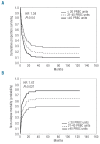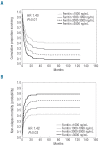Prognostic impact of pre-transplantation transfusion history and secondary iron overload in patients with myelodysplastic syndrome undergoing allogeneic stem cell transplantation: a GITMO study
- PMID: 19903678
- PMCID: PMC2833079
- DOI: 10.3324/haematol.2009.011429
Prognostic impact of pre-transplantation transfusion history and secondary iron overload in patients with myelodysplastic syndrome undergoing allogeneic stem cell transplantation: a GITMO study
Abstract
Background: Transfusion-dependency affects the natural history of myelodysplastic syndromes. Secondary iron overload may concur to this effect. The relative impact of these factors on the outcome of patients with myelodysplastic syndrome receiving allogeneic stem-cell transplantation remains to be clarified.
Design and methods: We retrospectively evaluated the prognostic effect of transfusion history and iron overload on the post-transplantation outcome of 357 patients with myelodysplastic syndrome reported to the Gruppo Italiano Trapianto di Midollo Osseo (GITMO) registry between 1997 and 2007.
Results: Transfusion-dependency was independently associated with reduced overall survival (hazard ratio=1.48, P=0.017) and increased non-relapse mortality (hazard ratio=1.68, P=0.024). The impact of transfusion-dependency was noted only in patients receiving myeloablative conditioning (overall survival: hazard ratio=1.76, P=0.003; non-relapse mortality: hazard ratio=1.70, P=0.02). There was an inverse relationship between transfusion burden and overall survival after transplantation (P=0.022); the outcome was significantly worse in subjects receiving more than 20 red cell units. In multivariate analysis, transfusion-dependency was found to be a risk factor for acute graft-versus-host disease (P=0.04). Among transfusion-dependent patients undergoing myeloablative allogeneic stem cell transplantation, pre-transplantation serum ferritin level had a significant effect on overall survival (P=0.01) and non-relapse mortality (P=0.03). This effect was maintained after adjusting for transfusion burden and duration, suggesting that the negative effect of transfusion history on outcome might be determined at least in part by iron overload.
Conclusions: Pre-transplantation transfusion history and serum ferritin have significant prognostic value in patients with myelodysplastic syndrome undergoing myeloablative allogeneic stem cell transplantation, inducing a significant increase of non-relapse mortality. These results indicate that transfusion history should be considered in transplantation decision-making in patients with myelodysplastic syndrome.
Figures



Comment in
-
Iron overload in hematologic malignancies and outcome of allogeneic hematopoietic stem cell transplantation.Haematologica. 2010 Mar;95(3):364-6. doi: 10.3324/haematol.2009.017244. Haematologica. 2010. PMID: 20207843 Free PMC article. No abstract available.
Similar articles
-
Impact of transfusion dependency and secondary iron overload on the survival of patients with myelodysplastic syndromes.Leuk Res. 2007 Dec;31 Suppl 3:S2-6. doi: 10.1016/S0145-2126(07)70459-9. Leuk Res. 2007. PMID: 18037415 Review.
-
A prospective non-interventional study on the impact of transfusion burden and related iron toxicity on outcome in myelodysplastic syndromes undergoing allogeneic hematopoietic cell transplantation.Leuk Lymphoma. 2019 Oct;60(10):2404-2414. doi: 10.1080/10428194.2019.1594215. Epub 2019 Apr 18. Leuk Lymphoma. 2019. PMID: 30997844
-
Impact of pre-transplant serum ferritin on outcomes of patients with myelodysplastic syndromes or secondary acute myeloid leukaemia receiving reduced intensity conditioning allogeneic haematopoietic stem cell transplantation.Leuk Res. 2010 Jun;34(6):723-7. doi: 10.1016/j.leukres.2009.10.028. Epub 2009 Nov 26. Leuk Res. 2010. PMID: 19944463
-
WHO classification and WPSS predict posttransplantation outcome in patients with myelodysplastic syndrome: a study from the Gruppo Italiano Trapianto di Midollo Osseo (GITMO).Blood. 2008 Aug 1;112(3):895-902. doi: 10.1182/blood-2008-03-143735. Epub 2008 May 22. Blood. 2008. PMID: 18497321
-
Clinical relevance of anemia and transfusion iron overload in myelodysplastic syndromes.Hematology Am Soc Hematol Educ Program. 2008:166-75. doi: 10.1182/asheducation-2008.1.166. Hematology Am Soc Hematol Educ Program. 2008. PMID: 19074076 Review.
Cited by
-
The role of magnetic resonance imaging in the evaluation of transfusional iron overload in myelodysplastic syndromes.Rev Bras Hematol Hemoter. 2015 Jul-Aug;37(4):252-8. doi: 10.1016/j.bjhh.2015.03.014. Epub 2015 May 19. Rev Bras Hematol Hemoter. 2015. PMID: 26190429 Free PMC article.
-
Advances in conditioning regimens for older adults undergoing allogeneic stem cell transplantation to treat hematologic malignancies.Drugs Aging. 2013 Jun;30(6):373-81. doi: 10.1007/s40266-013-0076-x. Drugs Aging. 2013. PMID: 23553513 Review.
-
The revolution of myelodysplastic syndromes.Ther Adv Hematol. 2011 Feb;2(1):33-43. doi: 10.1177/2040620710395652. Ther Adv Hematol. 2011. PMID: 23556074 Free PMC article.
-
The impact of iron chelation therapy on patients with lower/intermediate IPSS MDS and the prognostic role of elevated serum ferritin in patients with MDS and AML: A meta-analysis.Medicine (Baltimore). 2019 Oct;98(40):e17406. doi: 10.1097/MD.0000000000017406. Medicine (Baltimore). 2019. PMID: 31577751 Free PMC article.
-
Management of the Older Patient with Myelodysplastic Syndrome.Drugs Aging. 2021 Sep;38(9):751-767. doi: 10.1007/s40266-021-00881-3. Epub 2021 Aug 3. Drugs Aging. 2021. PMID: 34342860 Review.
References
-
- Cazzola M, Malcovati L. Myelodysplastic syndromes – coping with ineffective hematopoiesis. N Engl J Med. 2005;352(6):536–8. - PubMed
-
- Malcovati L, Della Porta MG, Pascutto C, Invernizzi R, Boni M, Travaglino E, et al. Prognostic factors and life expectancy in myelodysplastic syndromes classified according to WHO criteria: a basis for clinical decision making. J Clin Oncol. 2005;23(30):7594–603. - PubMed
-
- Della Porta MG, Malcovati L, Boveri E, Travaglino E, Pietra D, Pascutto C, et al. Clinical relevance of bone marrow fibrosis and CD34-positive cell clusters in primary myelodysplastic syndromes. J Clin Oncol. 2009;27(5):754–62. - PubMed
-
- Malcovati L, Della Porta MG, Cazzola M. Predicting survival and leukemic evolution in patients with myelodysplastic syndrome. Haematologica. 2006;91(12):1588–90. - PubMed
-
- Appelbaum FR, Barrall J, Storb R, Fisher LD, Schoch G, Ramberg RE, et al. Bone marrow transplantation for patients with myelodysplasia. Pretreatment variables and outcome. Ann Intern Med. 1990;112(8):590–7. - PubMed

